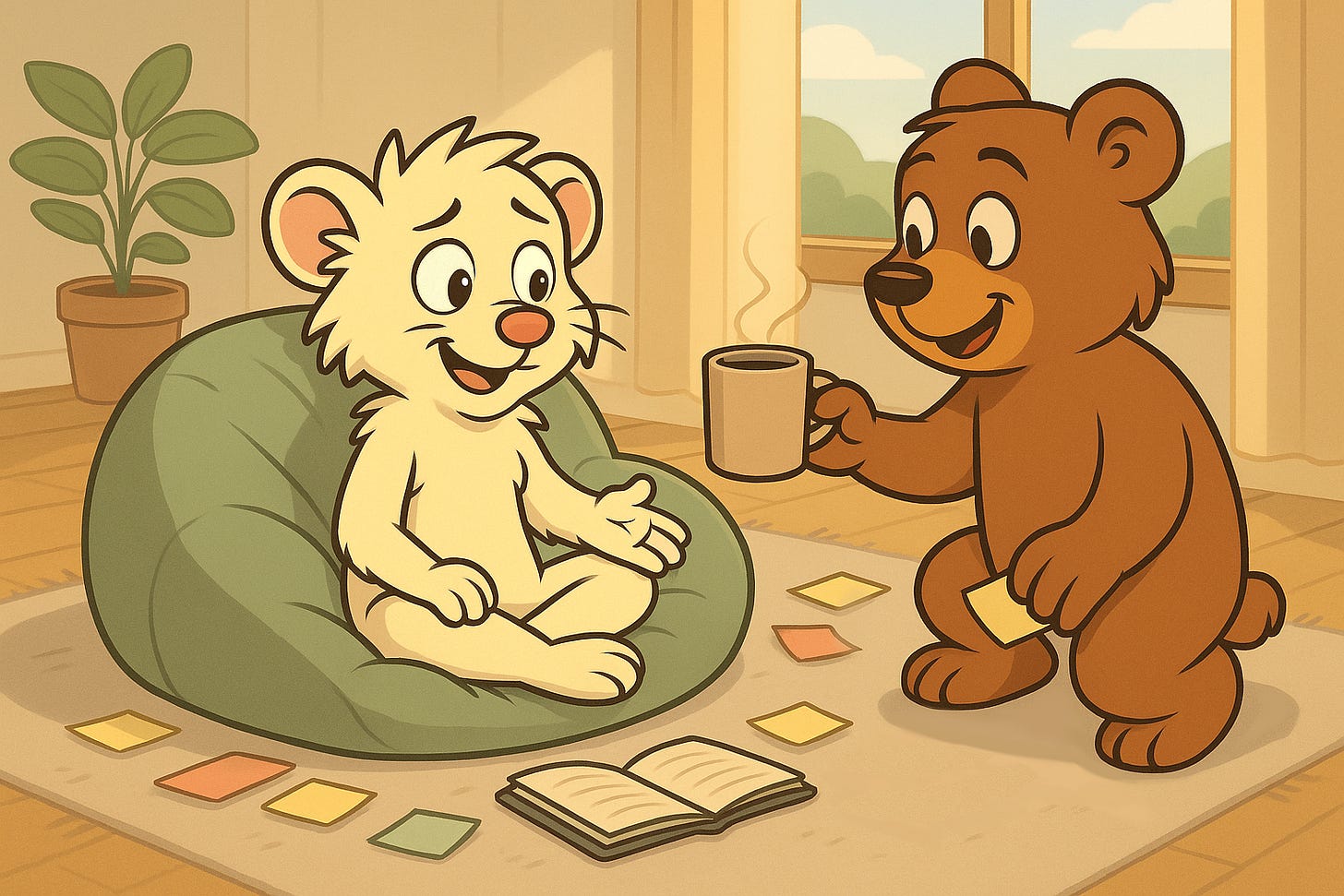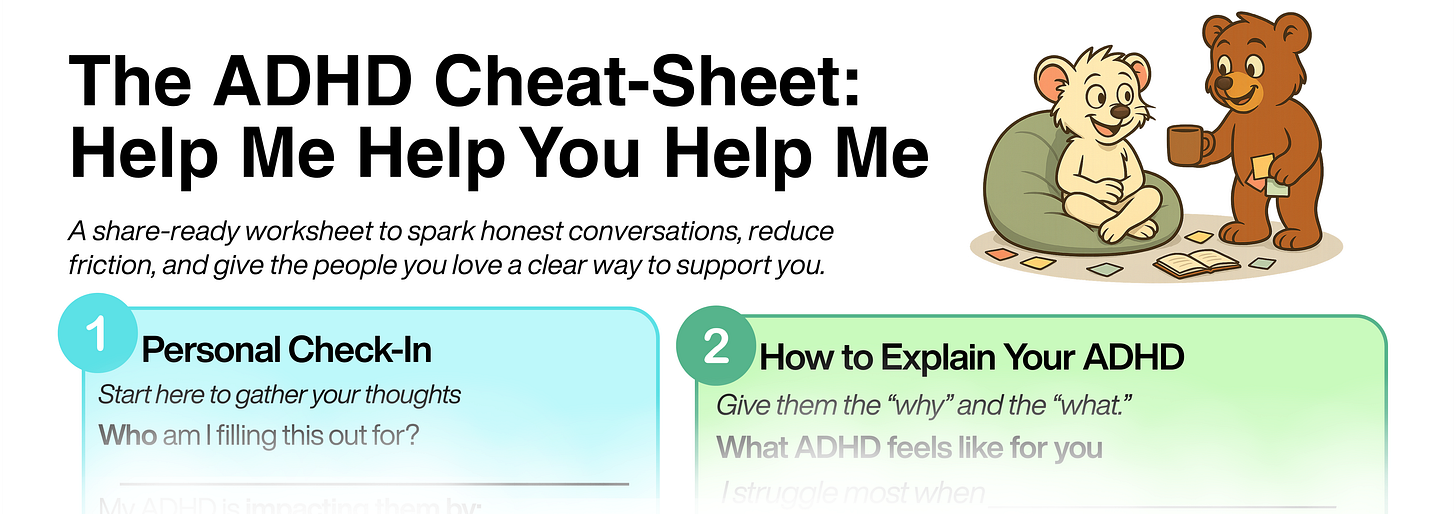How to help loved ones finally understand your ADHD
A guide to help your loved ones support your ADHD brain.
This week, I found myself having one of those late-night conversations with my partner, the kind where you start with “Hey, did you remember to put the laundry in?” and somehow end up talking about life, brains, and how they found my phone in a kitchen drawer, again.
Somewhere in the middle of that conversation, I was reminded that ADHD isn’t just our daily mountain to climb; it’s something our partners, friends, and families often end up hiking alongside us. Their support, or lack of understanding, can make a huge difference in whether we stay on a good path, feel completely misunderstood, or land somewhere in between.
Over the past few weeks, I’ve been re-reading ADHD 2.0 (Hallowell & Ratey). One line stuck with me: ADHD brains run on interest, novelty, and support. Not just professional help, but the kind that comes from the people who know us best. And yet, explaining this stuff to those people can feel impossible, draining, or worse, it just doesn’t land the way we want.
This newsletter is different from our other issues. It’s not just for you; it’s for your people too. The ones who want to help but don’t always know how. We’ll break down what support really looks like, share a few ways you can explain ADHD in a way that sticks, and at the end, you’ll get a gentle worksheet you can fill out and share with someone you trust.
Because living with ADHD can be hard. Living with someone with ADHD? Also hard. Understanding each other? That’s how we both win.
Seeing it from their side (a non-ADHD perspective)
Before we hand our loved ones a “how to support me” checklist, which you’ll find in this week’s worksheet, let’s step into their shoes for a moment. A thread I came across this week spelled it out: people who live with us often feel like they’re running a pop-up “Where did you put your keys?” hotline. It hit home. My partner could charge per call and retire early.
Here is what life with us can feel like from the non-ADHD side. Conversations veer off mid-sentence and plans disappear from the radar, leaving them unsure if they were heard at all. When we are overwhelmed, everyday logistics such as bills, appointments, and picking up the same pair of shoes for the sixth time tend to land on their plate, and researchers link this invisible workload to higher caregiver burnout. Add in the emotional aftershocks of rejection sensitivity, where a tiny critique sparks a big reaction, and suddenly our loved ones are tiptoeing around ordinary feedback. No wonder many partners say they feel more like managers than teammates.
Naming these realities does not erase our ADHD challenges; it simply levels the playing field. When the people who support us feel seen and validated, they can listen with softer ears and help us find solutions instead of slipping into frustration. Empathy flows both ways, and starting here opens the door for real conversation.
Turning understanding into action
Once we acknowledge the hidden weight our friends, parents, partners, or coworkers may feel, the next step is figuring out how to ask for help in a way that lands. Showing them concrete ways to respond. Below are four approaches that work well beyond romantic couples.
1. Start with a Specific Ask
Vague requests like “remind me about stuff” can overwhelm the helper. Instead, name one slice of support you need:
“Could you text me at 4 p.m. to stretch for five minutes before I dive into hyperfocus?” Clear, time-bound asks reduce caregiver strain and increase follow-through.
2. Offer a Strengths Snapshot
Many guides suggest beginning with what you do well: creativity, humor, crisis problem-solving. Research on strengths-based ADHD coaching shows that framing needs in the context of existing strengths improves motivation on both sides.
“My quick ideas help the team, but I lose track of next steps. Can we create a shared checklist?”
3. Choose a Shared System, Not a Personal Reminder
Repeated verbal prompts feel like nagging. Shared calendars, whiteboards, or weekly “download sessions” spread the load and lower our loved one’s burnout.
Set up a family Google calendar or a Sunday ten-minute plan-and-tea ritual where everyone lists their top tasks.
4. Use Body Doubling Beyond Work
Body doubling, working in the presence of another person, also keeps chores, bill paying, or homework on track. Invite a sibling, roommate, or friend to sit nearby while you tackle paperwork, and then swap roles.
Help Your People Get Your ADHD (Worksheet)
As we mentioned above, explaining how your ADHD brain works to your inner circle is important. However, it can feel impossible to get done in a single conversation, and repeating it drains everyone. This one-page worksheet turns the awkward “let me explain my brain” talk into a quick fill-in card you can text, print, or stick on the fridge.




